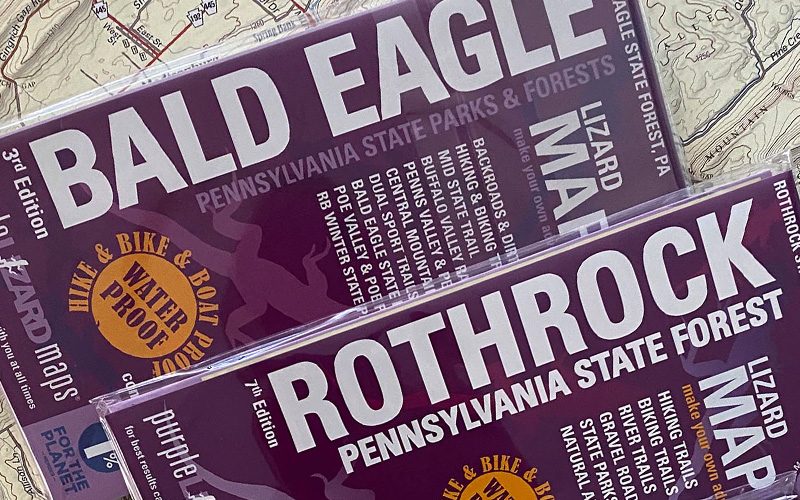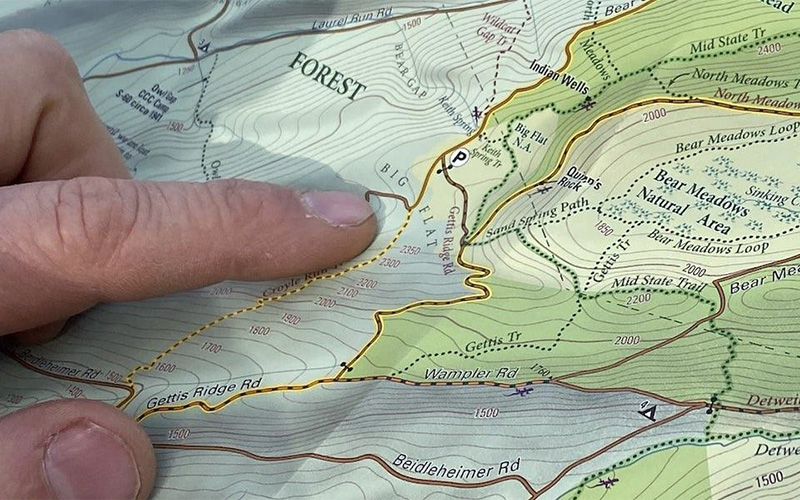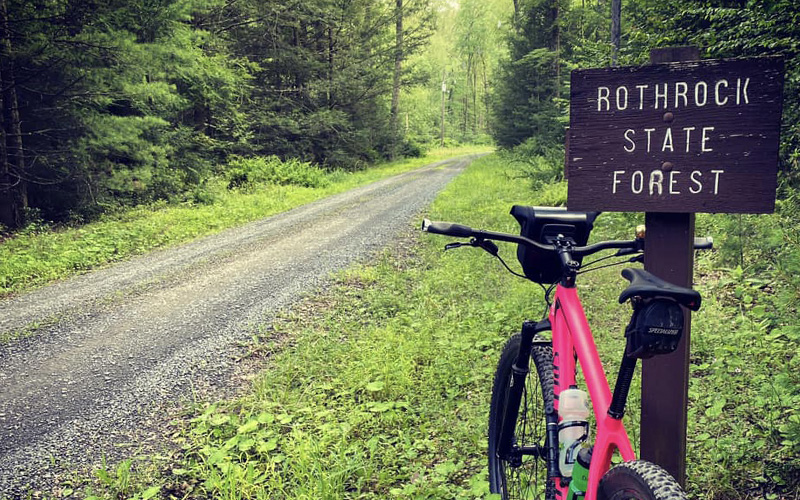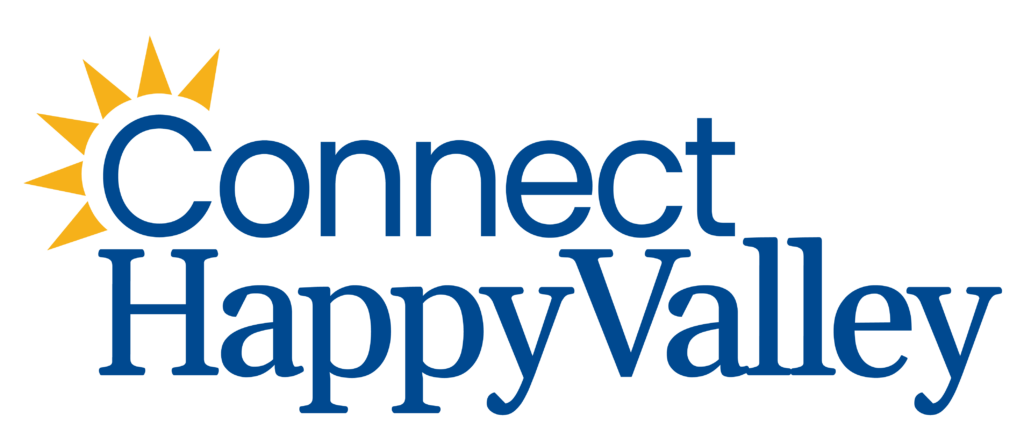by Cara Aungst
 Purple Lizard maps showcase Happy Valley’s outdoor recreation assets.
Purple Lizard maps showcase Happy Valley’s outdoor recreation assets.
On the day of our interview, Mike Hermann and his team were days away from finishing their 17th map. The map represented more than a thousand hours spent over two years, starting with hiking boots on the ground exploring the trailheads and ravines of a specific outdoor recreation destination and ending with proofs of Purple Lizard’s signature waterproof, rugged maps that Hermann calls “such works of art.” And in spite of all the blisters, long nights and research that went into the map, Hermann says that what happens next is the real magic. Each time a Purple Lizard map showcases outdoor recreation assets in a new area, economic growth happens.
“Purple Lizard Maps has been a big driver of recreational tourism and recreation economies in every community where we develop a Lizard Map,” Hermann said. “For many communities, outdoor recreation is the future of economic development. When the maps showcase the local assets, more people can easily explore the destinations. They become larger and more diverse, becoming gateway towns. This elevates tourism and gives shops more things to sell. Realtors start selling to people interested in outdoor recreation. Our maps send new faces to outfitters, looking for gear. These small towns become destinations.”
Each time a Purple Lizard map showcases outdoor recreation assets in a new area, economic growth happens.
We don’t have to look far to find an example of how outdoor recreation can boost a community, Hermann said. “Look at Millheim. Fifteen years ago, it was not somewhere you went to spend half of a day. But soon it got Elk Creek Cafe + Aleworks and a coffee shop, [and is a place where people stop after a day of biking or hiking at Poe Valley]. Another great example is the Buffalo Valley Rail Trail that connects Mifflinburg to Lewisburg. Within two years of that trail being built, two bike shops relocated to storefronts located on the rail trail. We see this a lot in communities where we map — towns are trying to move away from natural resource extraction and become gateway communities.”
Hermann said that Purple Lizard maps, which chart adventures from Raystown Lake to the Shenandoah Valley, are now distributed by companies like REI, and LL Bean, and that has grown the outdoor assets even more. “If you walk into the REI flagship store in Washington, DC, you will find a map to Bald Eagle State Forest, and discover that you can be in the mountains in just three hours and have a really nice weekend escape.

So what about Happy Valley?
Mike Hermann got his B.A. in Geography from Penn State and started his career as a Digital Cartographic Specialist with Trails Illustrated/National Geographic Maps in Colorado.
“I went there thinking I was going to a recreational paradise, but it wasn’t,” he said. “If I didn’t leave work before five, there were no parking spaces left at a trailhead. I would get on the trail and be hiking behind people the whole way to the overlook … and then stand behind 20 people, waiting to see the view. It wasn’t what I thought.”
I saw Pennsylvania as the outdoor mecca that no one knew about. I decided that if I started to do trail maps about what was here, people could see it for what it was.
“Vail, Colorado is a great place for the super fit,” he said with a laugh, “But regular people can have a great adventure in Central Pennsylvania — it’s for all of us. There is so much to do within 25 minutes of downtown State College. We take it for granted.”
“There is such a tremendous variety of outdoor recreation available. You can decide to ski and be on a slope in 15 minutes. That’s extremely rare. Or jump on a bike and have access to so many trails.”
He said that his time in the Rocky Mountains led to his aha moment.
“When I was a cartographer in Colorado, I saw how maps drove outdoor recreation in the West. I thought to myself, ‘Pennsylvania has just as many outdoor assets, but they aren’t as well known. I saw Pennsylvania as the outdoor mecca that no one knew about. I decided that if I started to do trail maps about what was here, people could see it for what it was.”

Growth mindset from the seat of a mountain bike
This past year, the Department of Conservation and Natural Resources announced that outdoor recreation contributed $13.64 billion to Pennsylvania’s economy and is the 6th largest state in terms of outdoor recreation. Hermann is not surprised. “I’ve seen steady growth ever since I moved back to Pennsylvania,” he said. “There has been such a growth in mountain biking and kayaking over the past 25 years. Being outside is the antidote to the overload of technology in our lives. We spend an inordinate amount of time tethered to our devices and this is a chance to be immersed in something real.”
What can Happy Valley to capitalize on this shift? It’s already happening, he said. “There is an embarrassment of riches and we are seeing trail systems grow and progress to satisfy the needs of the community. Harvest Fields Community Trails (a beginner trail system located near Boalsburg) happened because the community identified something that was missing and came together to make it happen.
Continually creating recreational assets is the key to growth. A movie theatre doesn’t just play the same movie for six months. As outdoor recreation grows, we need to plan for that so we don’t end up with the same problems that bigger communities have with overuse issues.”
By the end of the interview, Hermann muses out loud about what he is going to do when the call is over. “I could take a hike with my wife and dog, take the kayak out to Colyer Lake or see the sunset on my motorcycle. What a luxury to have those kinds of choices — it’s an incredible quality of life.”

